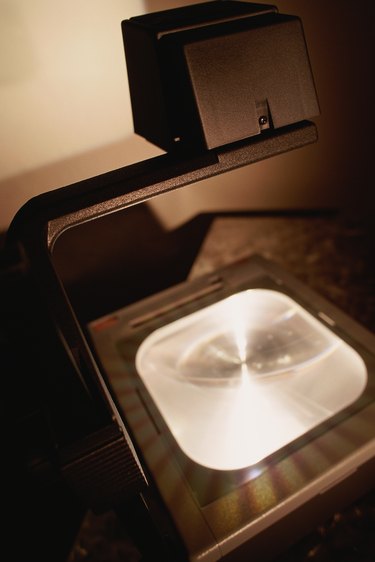
Before the advent of the data projector, overhead projectors ruled the boardroom. They allowed you to create large slides on transparency film and project them to the room. You could even write directly on the slide with wet-erase markers, letting you merge your presentation with a whiteboard. While overhead projectors have become much rarer, they are still useful tools for sharing older transparencies or creating a truly interactive presentation.
Lamp and Box
Video of the Day
The largest part of an overhead projector is the box at its base. The box contains two key components – a lamp and a cooling fan. Overhead projector lamps typically consume hundreds of watts of power to generate thousands of lumens of light output. They have two key drawbacks. First, many of them use a filament like a traditional incandescent light bulb that quickly burns out, giving many projectors under 100 hours of lamp life. Second, they generate a great deal of heat that gets vented out of the box by a quickly spinning and sometimes distractingly loud cooling fan.
Video of the Day
Fresnel Lens and Plate Glass
You place your slide or projection panel on a large piece of glass, called the stage glass, on top of the projector's main box. Underneath that glass, the projector has a special type of lens called a fresnel lens. These lenses, which are usually made of plastic, magnify the bulb, spreading its light over the entire plate glass. Fresnel lenses are also used in credit-card sized magnifiers.
Upper Lens Assembly
The projector's upper lens assembly, called a head, collects and projects the light that passes from the bulb through the fresnel lens and the projection media. The side facing down towards the stage glass has a lens, while the head contains a mirror that directs the light outward through its side-facing port or lens. The head is usually height-adjustable to allow you to vary the focus of the image.
Projection Media
Without projection media, a projector is just a big light box. Overhead projectors typically use transparency film. Usually made of acetate, transparencies are frequently letter-sized and can be bought with different surfaces to allow them to be written on, copied onto, laser printed or inkjet printed. If you need to project images from a computer or other video source through your overhead projector, you can also use a projection panel. These are like laptop screens, but without back lighting or a back panel. The light from the projector passes through them and into the focusing lens, much like in a liquid-crystal display data projector.